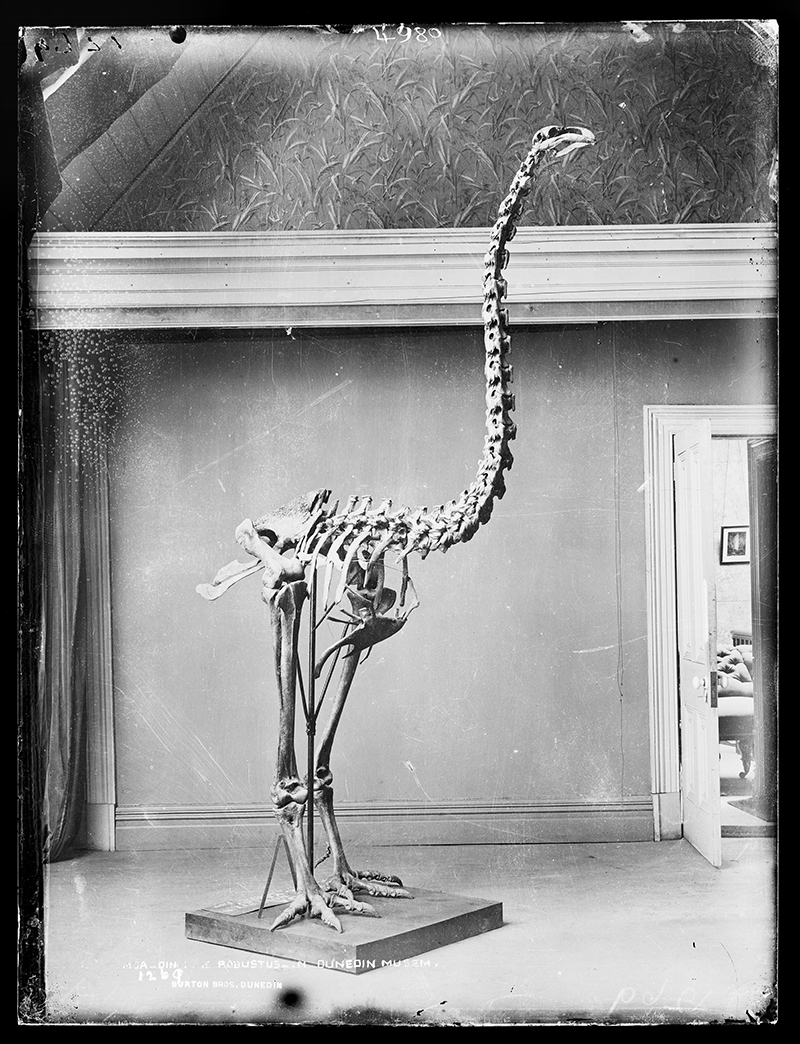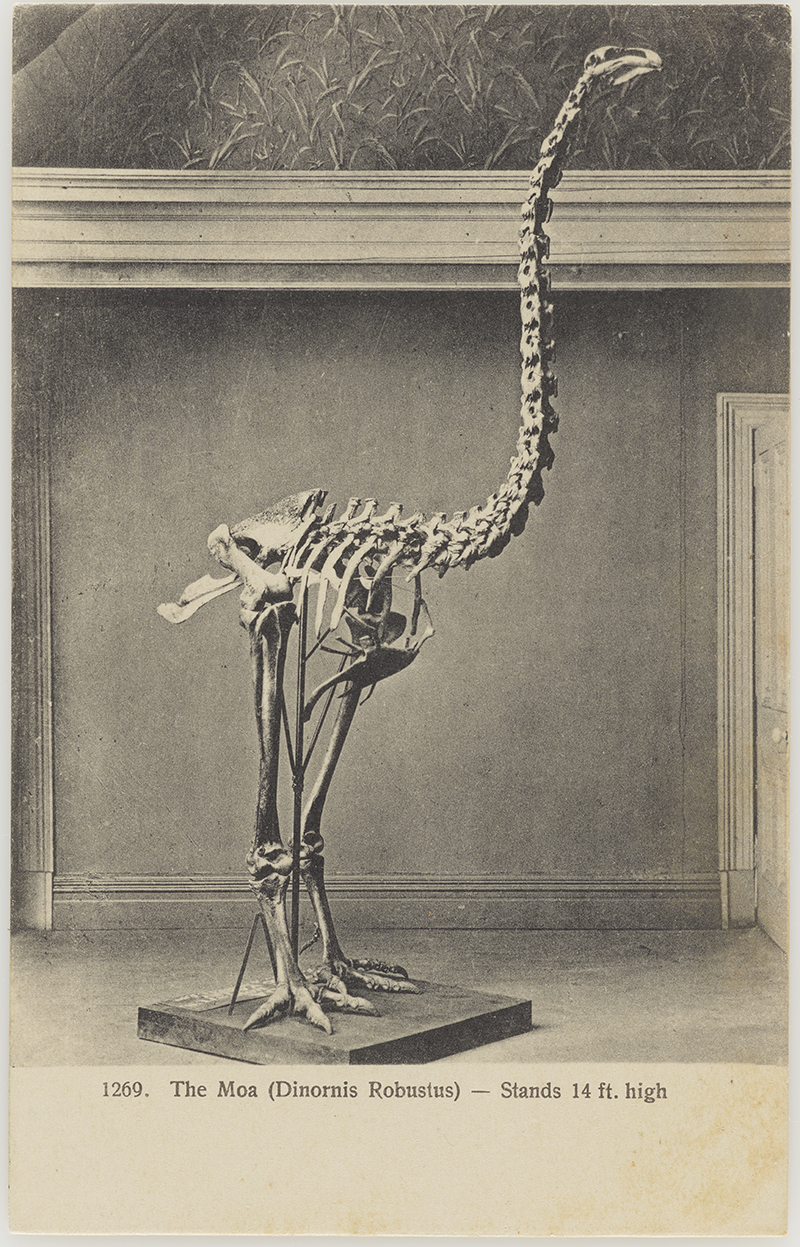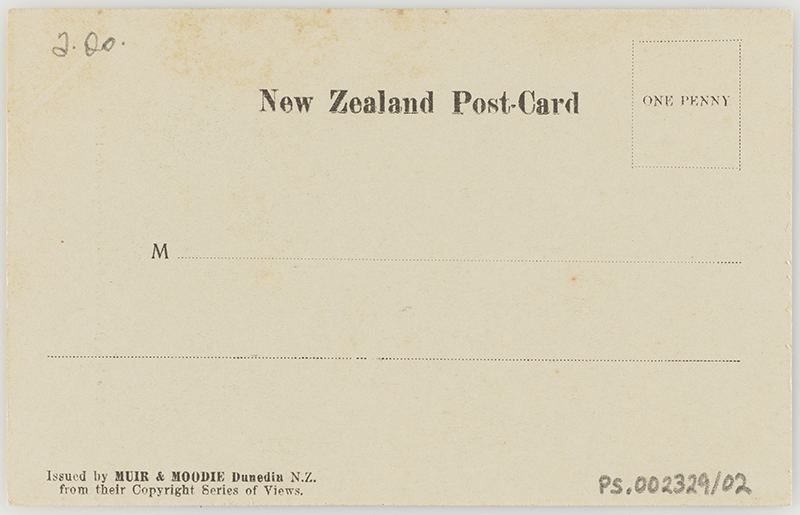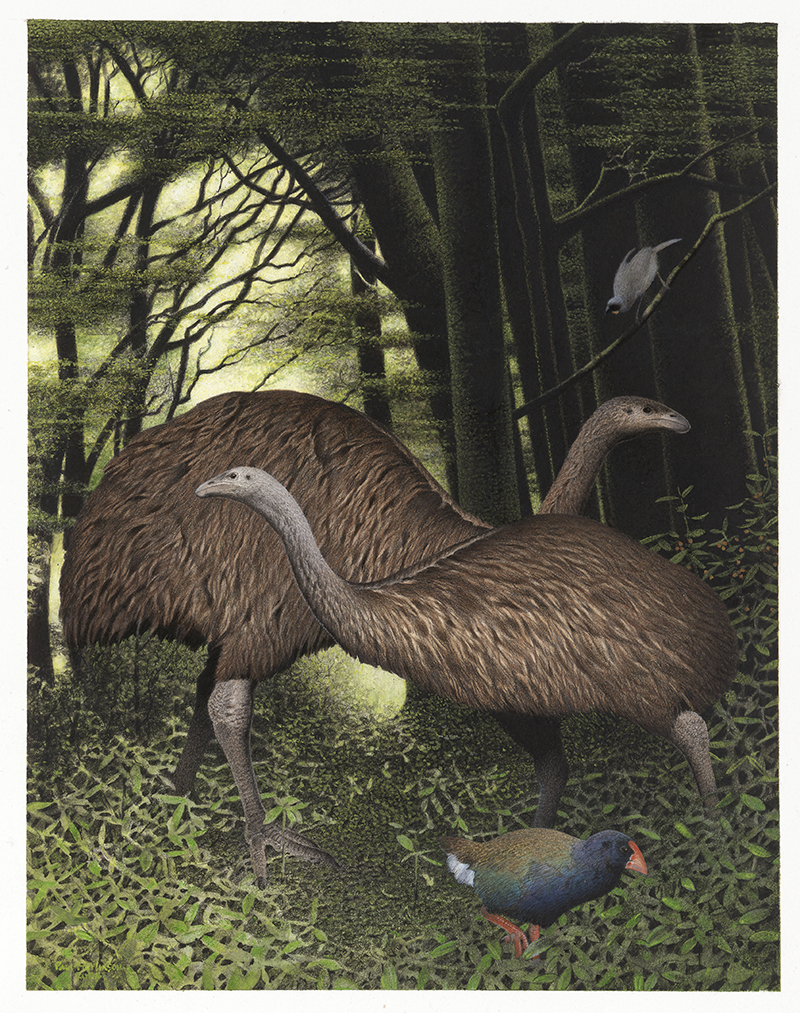Dinornis robustus (Owen, 1846:48)
South Island giant moa, Moa Nunui (Māori)
Taxonomy & Nomenclature
Synonyms: Dinornis ingens robustus Owen, 1846:48; Palapteryx robustus (Owen, 1846:48); Dinornis robustus (Owen, 1846:48); Dinornis maximus Haast, 1869:87; Dinornis altus Owen, 1879:361; Dinornis validus Hutton, 1891:247; Dinornis torosus Hutton, 1891:247; Dinornis potens Hutton, 1891:247; Palapteryx plenus Hutton, 1891:248; Dinornis strenuus Hutton, 1893:8
A complete synonymy taken from (Checklist Committee (OSNZ), 2022:19):
Dinornis ingens robustus Owen, 1846: Proc. Zool. Soc. London 1846 (14): 48 – Waikouaiti, Otago.; Palapteryx robustus (Owen); Owen 1851, Trans. Zool. Soc. London 4(1): 2, pl. 1, fig. 1.; Dinornis robustus (Owen); Bunce et al. 2003; Nature 425: 174.; Dinornis maximus Haast, 1869: Trans. N.Z. Inst. 1: 87 – Glenmark, Canterbury.; Dinornis altus Owen, 1879: Extinct Wingless Birds New Zealand: 361 – South Island.; Dinornis validus Hutton, 1891: New Zealand Journ. Sci. (new series) 1(6): 247 – Glenmark, Canterbury.; Dinornis torosus Hutton, 1891: New Zealand Journ. Sci. (new series) 1(6): 247 – Takaka Hill, Nelson.; Dinornis potens Hutton, 1891: New Zealand Journ. Sci. (new series) 1(6): 247 – Heathcote, Canterbury.; Palapteryx plenus Hutton, 1891: New Zealand Journ. Sci. (new series) 1(6): 248 – ?South Island.; Dinornis strenuus Hutton, 1893: Trans. N.Z. Inst. 25: 8 – Enfield, Canterbury.
Conservation Status
Extinct
Last record: 1297–1395 CE (95.4% CI) (Verry et al., 2022)
Distribution
South Island (including D’Urville Island) & Stewart Island (Rakiura), New Zealand
Biology & Ecology
Hypodigm
Museum of New Zealand Te Papa Tongarewa:
Media

Above: Moa, Dinornis robustus, North Dunedin Museum, circa 1880, Dunedin, by Burton Brothers. Purchased 1943. Te Papa (C.014980)

Above (front of postcard): The Moa (Dinornis Robustus), 1900-1903, Dunedin, by Muir & Moodie. Purchased 1998 with New Zealand Lottery Grants Board funds. Te Papa (PS.002329/02)

Above (back of postcard): The Moa (Dinornis Robustus), 1900-1903, Dunedin, by Muir & Moodie. Purchased 1998 with New Zealand Lottery Grants Board funds. Te Papa (PS.002329/02)

Above: South Island Giant Moa. Dinornis robustus. From the series: Extinct birds of New Zealand., 2005, Masterton, by Paul Martinson. Purchased 2006. © Te Papa. CC BY-NC-ND 4.0. Te Papa (2006-0010-1/18)
https://www.youtube.com/watch?v=qlLuS49oYUo
References
Original scientific description:
Owen, R. (1846) Proc. Zool. Soc. London, 14:48
Other references:
Allentoft, Morten E., Bunce, Michael et al. (2010). Highly skewed sex ratios and biased fossil deposition of moa: ancient DNA provides new insight on New Zealand's extinct megafauna. Quaternary Science Reviews 29(5-6): 753-762. [Abstract]
Allentoft, Morten E., Heller, R., Holdaway, R. N. and Bunce, M. (2015). Ancient DNA microsatellite analyses of the extinct New Zealand giant moa (Dinornis robustus) identify relatives within a single fossil site. Heredity. doi:10.1038/hdy.2015.48 [Abstract]
Allentoft, Morton E., Scofield, R. P., Oskam, C. L.,Hale, M. L., Holdaway, Richard N. and Bunce, M. (2011). A molecular characterization of a newly discovered megafaunal fossil site in North Canterbury, South Island, New Zealand. Journal of the Royal Society of New Zealand 42(4): 241-256.
Allis, T. (1865a). Notice of a nearly complete skeleton of Dinornis; presented by Mr Gibson to the Museum of Yorkshire Philosophical Society.Journal of the Proceedings of the Linnaean Society 8: 50-52.
Allis, T. (1865b). Further note on a skeleton of Dinornis robustus, Owen, in the York Museum. Journal of the Proceedings of the Linnaean Society 8: 140-141.
Anonymous. (1999). Moa Hunt is On. Crypto 2(2): 17.
Attard, M. R. G., Wilson, L. A. B., Worthy, T. H., Scofield, P., Johnston, P., Parr, W. C. H. and Wroe, S. (2016). Moa diet fits the bill: virtual reconstruction incorporating mummified remains and prediction of biomechanical performance in avian giants. Proc. R. Soc. B 283: 20152043.
Baker, Allan J. et al. (2005). Reconstructing the tempo and mode of evolution in an extinct clade of birds with ancient DNA: The giant moas of New Zealand. PNAS 102(23): 8257-8262.
Bishop, Peter J. (2015). A critical re-evaluation of the hindlimb myology of moa (Aves: Dinornithiformes). Memoirs of the Queensland Museum - Nature 59: 187-246. [automatic download]
Bunce, M. et al. (2003). Extreme reversed sexual size dimorphism in the extinct New Zealand moa Dinornis. Nature 425(6954): 172-175.
Bunce, M. et al. (2009). The evolutionary history of the extinct ratite moa and New Zealand Neogene Paleogeography. Proceedings of the National Academy of Science 106(49): 20646-20651.
Checklist Committee (OSNZ). (2010). Checklist of the Birds of New Zealand, Norfolk and Macquarie Islands, and the Ross Dependency, Antarctica (4th ed.). Ornithological Society of New Zealand & Te Papa Press, Wellington. [p. 18]
Checklist Committee (OSNZ). (2022). Checklist of the Birds of New Zealand (5th edition). Ornithological Society of New Zealand Occasional Publication No. 1. Wellington: Ornithological Society of New Zealand. [p. 19]
Cooper A, Lalueza-Fox C, Anderson S, Rambaut A, Austin J, and Ward R (2001) Complete mitochondrial genome sequences of two extinct moas clarify ratite evolution. Nature 409, 704–707.
Dallas, W. S. (1865a). On the feathers of Dinornis robustus, Owen, a skeleton in the Yorkshire Museum. Proceedings of the Zoological Society of London for (3) 5: 265-268.
Dallas, W. S. 1865b. On the feathers of Dinornis robustus. Annals and Magazine of Natural History (3) 16:66-69. PDF (No direct access outside the US)
Dallas, W. S. 1865c. Note sur les plumes de Dinornis rubustus (Extr.). Annales des Sciences Naturelles (Zool. Paléont.) (5) 4: 292.
Göhlich, Ursula B. (2017). Catalogue of the fossil bird holdings of the Bavarian State Collection of Palaeontology and Geology in Munich. Zitteliana 89: 331-349.
Hume, Julian Pender and Walters, Michael. (2012). Extinct Birds. London: T & AD Poyser.
Huynen L, Millar C D, Scofield RP, and Lambert DM (2003) Nuclear DNA sequences detect species limits in ancient moa. Nature 425, 175–178.
Knox, Alan G. and Walters, Michael P. (1994). Extinct and endangered birds in the collections of The Natural History Museum. British Ornithologists' Club Occasional Publications 1: 1-292. [p. 277 as Dinornis maximus]
Malý, Radek (author), Grbavčič, Jiří (illustrator) and Dvorský, Pavel (illustrator). (2022). Atlas of Extinct Animals. Albatros nakladatelstvi as [Albatros Media]. 88/96 pp.
McCallum, J., Hall, S., Lissone, I., Anderson, J., Huynen, L. and Lambert, D. M. (2013). Highly Informative Ancient DNA ‘Snippets’ for New Zealand Moa. PLoS ONE 8(1): e50732.
Oskam, Charlotte L. et al. (2010). Fossil avian eggshell preserves ancient DNA. Proc. R. Soc. B DOI: 10.1098/rspb.2009.2019
Oskam, Charlotte L. et al. (2012). Ancient DNA analyses of early archaeological sites in New Zealand reveal extreme exploitation of moa (Aves: Dinornithiformes) at all life stages. Quaternary Science Reviews 52: 41-48. [Abstract]
Owen, Richard. (1866). On Dinornis (part IX): containing a description of the skull, atlas, and scapulo-coracoid bone of Dinornis robustus. Transactions of the Zoological Society of London 5: 337-358.
Owen, Richard. (1869). On Dinornis (Part XI): containing a description of the integument of the sole, and tendons of a toe, of the foot of Dinornis robustus, Owen. Transactions of the Zoological Society of London 6: 495-496.
Rawlence, Nicolas J. et al. (2009). DNA content and distribution in ancient feathers and potential to reconstruct the plumage of extinct avian taxa. Proceedings of the Royal Society, B 276(1672): 3395-3402.
Rawlence, N. J., Wood, J. R., Scofield, R. P., Fraser, C. and Tennyson, Alan J. D. (2012). Soft-tissue specimens from pre-European extinct birds of New Zealand. Journal of the Royal Society of New Zealand iFirst 2012: 1-28.
Robertson, H. A., Baird, K. A., Elliott, G. P., Hitchmough, R. A., McArthur, N. J., Makan, T. D., Miskelly, Colin M., O’Donnell, C. F. J., Sagar, P. M., Scofield, R. P., Taylor, G. A. and Michel, P. (2021). Conservation status of birds in Aotearoa New Zealand, 2021. New Zealand Threat Classification Series 36. Department of Conservation, Wellington. 43 pp.
Hugh Robertson, John Dowding, Graeme Elliott, Rod Hitchmough, Colin Miskelly, Colin O’Donnell, Ralph Powlesland, Paul Sagar, Paul Scofield, Graeme Taylor. (2013). Conservation status of New Zealand birds, 2012. New Zealand Threat Classification Series 4. 22 pp.
Sayol, Ferran, Steinbauer, Manuel J., Blackburn, Tim M., Antonelli, Alexandre and Faurby, Søren. (2020). Anthropogenic extinctions conceal widespread evolution of flightlessness in birds. Science Advances 6(49): eabb6095. https://doi.org/10.1126/sciadv.abb6095 [Supplementary Material (Data File S1)]
Turvey, Samuel T. (2009). In the shadow of the megafauna: prehistoric mammal and bird extinctions across the Holocene, pp. 17-39. In: Turvey, Samuel T. (ed.). Holocene Extinctions. New York: Oxford University Press.
Tyrberg, Tommy. (2009). Holocene avian extinctions, pp. 63-106. In: Turvey, Samuel T. (ed.). Holocene Extinctions. Oxford, UK & New York, USA: Oxford University Press. xii + 352 pp.
Verry, Alexander J. F., Schmidt, Matthew and Rawlence, Nicolas J. (2022). A partial skeleton provides evidence for the former occurrence of moa populations on Rakiura Stewart Island. New Zealand Journal of Ecology 46(1): 3458.
Wood, Jamie R. (2007). Moa gizzard content analyses: further information on the diets of Dinornis robustus and Emeus crassus, and the first evidence for the diet of Pachyornis elephantopus (Aves: Dinornithiformes). Records of the Canterbury Museum 21: 27-39.
Wood, Jamie R., Rawlence, Nicolas J., Rogers, Geoffrey M., Austin, Jeremy J., Worthy, Trevor H. and Cooper, Alan. (2008). Coprolite deposits reveal the diet and ecology of the extinct New Zealand megaherbivore moa (Aves, Dinornithiformes). Quaternary Science Reviews 27(27-28): 2593-2602.
Wood, Jamie R. (2009). Two Late Quaternary avifaunal assemblages from the Dunback district, eastern Otago, South Island, New Zealand. Notornis 56: 154-157.
Wood, Jamie R., Wilmshurst, J. M., Rawlence, N. J., Bonner, K. I., Worthy, Trevor H. et al. (2013). A Megafauna’s Microfauna: Gastrointestinal Parasites of New Zealand’s Extinct Moa (Aves: Dinornithiformes). PLoS ONE 8(2): e57315.
Wood, J. R., Janet M. Wilmshurst, Sarah J. Richardson, Nicolas J. Rawlence, Steven J. Wagstaff, Trevor H. Worthy and Alan Cooper. (2013). Resolving lost herbivore community structure usingcoprolites of four sympatric moa species (Aves: Dinornithiformes). Proceedings of the National Academy of Sciences of the United States of America 110(42): 16910-16915.
Worthy, Trevor H. (1994). Reappraisal of Dinornis (Aves: Dinornithiformes) species—a morphometric analysis. New Zealand Journal of Zoology 21(2): 113-134.
Worthy TH, Bunce M, Cooper A and Scofield P (2005) Dinornis – an insular oddity, a taxonomic conundrum reviewed. Monogra; es de la Societat d’Història Natural de les Balears 12, 377–390.
Worthy, T. H. and Holdaway, R. N. (1994). Quaternary fossil faunas from caves in Takaka Valley and on Takaka Hill, northwest Nelson, South Island, New Zealand. Journal of The Royal Society of New Zealand 24(3): 297-391.
Worthy TH and Holdaway RN (2002) The Lost World of the Moa. Indiana University Press, Bloomington.
Wragg, Graham M. (1981). The birds of Canterbury: history and present status. A dissertation presented as a requirement for the Diploma in Parks and Recreation (National Parks option). Lincoln College, New Zealand.
Yaldwyn, J. C. (1959). Name changes in the Moa genus Dinornis. Notornis 8(6): 175.
Zinoviev, Andrei V. (2012). Notes on pelvic and hindlimb myology and syndesmology of Emeus crassus and Dinornis robustus (Aves: Dinornithiformes), pp. 32. In: Worthy, Trevor H. and Göhlich, Ursula B. (eds.). 8th International Meeting of the Society of Avian Paleontology and Evolution, Abstracts.
Zinoviev, A. V. (2013). Notes on the pelvic musculature of Emeus crassus and Dinornis robustus (Aves: Dinornithiformes). Paleontological Journal 47(11): 1245-1251. [Abstract]
http://www.nzherald.co.nz/nz/news/article.cfm?c_id=1&objectid=11176750
http://extinctanimals.proboards.com/thread/9344/dinornis-robustus-south-island-giant
